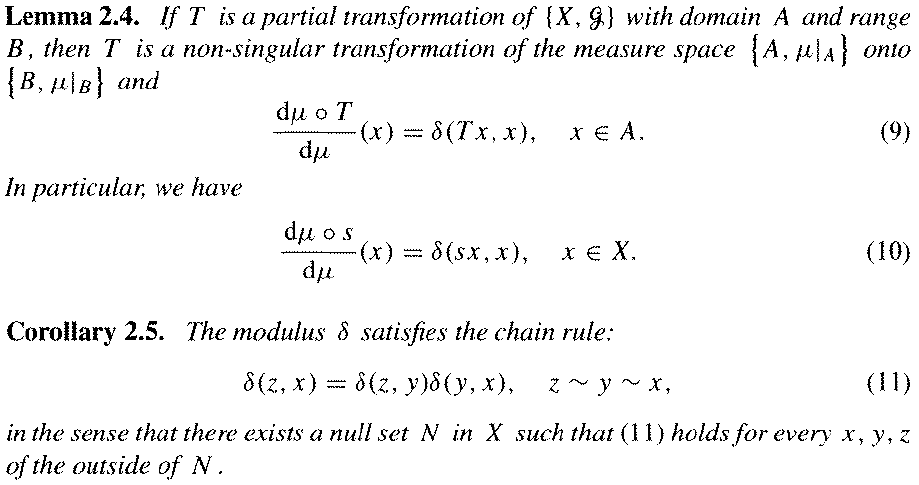We define below a von Neumann algebra $\mathcal{M}$ from an action of the free group on the circle, and we prove that $\mathcal{M}$ is a non-hyperfinite type ${\rm III}$ factor.
Question : Is $\mathcal{M}$ of type ${\rm III}_{0}$, ${\rm III}_{\lambda}$ or ${\rm III}_{1}$ ?
Definition : Let $s, r_{\theta}: \mathbb{R} / \mathbb{Z} \to \mathbb{R} / \mathbb{Z} $, defined by $s( x) = x^{2}$ (choosing representatives in $[0,1[$) and $r_{\theta} (x) = x+\theta$. Now, identifying $ \mathbb{R} / \mathbb{Z}$ and $\mathbb{S}^{1}$, we define the action $\alpha$ of $\mathbb{F}_{2} = \langle a, b \vert \ \rangle$, generated by $\alpha (a) = s$ and $\alpha (b) = r_{\theta}$ in Homeo($\mathbb{S}^{1}$).
Lemma: If $\theta$ is transcendental, the action $\alpha$ is faithful.
Proof: A relation $s^{n_{1}}r_{\theta}^{m_{1}}...s^{n_{k}}r_{\theta}^{m_{k}} = e $ can be translated into an algebraic equation in $x$ and $\theta$, where $\theta$ has to be a root $\forall x$. Then, if $\theta$ is transcendental, we are sure that there is no relation. $\square$
Remark: For a fixed transcendental $\theta$, each non-trivial relations can be realized for at most finitely many $x \in \mathbb{R} / \mathbb{Z}$, i.e. roots of the related algebraic equation.
Theorem: $\mathcal{M} = L^{\infty}(\mathbb{S}^{1}, Leb) \rtimes_{\alpha} \mathbb{F}_{2} $ is a non-hyperfinite type III factor.
Proof : The action $\alpha$ of $\mathbb{F}_{2}$ on $\mathbb{S}^{1}$ is:
- (a) Measure class preserving: the set of null measure subspaces is invariant.
- (b) Essentially free: a fixed point set for $\gamma \ne e$ is at most finite, so with null measure.
- (c) Properly ergodic: ergodicity comes from irrational rotation, next, every $\mathbb{F}_{2}$-orbit have null measure.
- (d) Non-amenable (Edit, Aug. 2018): for any $\eta > 0$, there is $n \in \mathbb{Z}_{>0}$ such that $\lfloor n\theta \rfloor < \eta$. Now, for $\lambda=Leb$ and $g = r_{\theta}^n$, $\partial (\lambda g)/\partial \lambda = 1$ because $\lambda$ is $g$-invariant. It follows that the action $\alpha$ is indiscrete, and then by the proposition below, it is non-amenable.
(e) Non equivalent measure preserving: by ergodicity, an equivalent invariant measure $m$ is proportional to $Leb$. Then $m([1/4 , 1/2]) = 2m([1/16 , 1/4])$, and by $\alpha(a)$ invariance, $m([1/4 , 1/2]) = m([1/16 , 1/4])$. In fact, the only invariant measure are $0$ or $\infty$.
(a), (b), (c) give a factor, (d) gives non-hyperfinite, (e) gives a type ${\rm III}$. $\square$
Here are two extracts of the following recent paper (April 2018):





